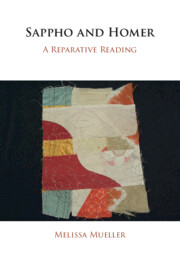Book contents
- Sappho and Homer
- Sappho and Homer
- Copyright page
- Dedication
- Contents
- Acknowledgments
- A Note on Texts and Abbreviations
- Introduction
- Part I Reparative Reading
- Part II Sappho and Homer
- Chapter 3 Plaiting and Poikilia
- Chapter 4 Aphrodite and the Poetics of Shame
- Chapter 5 In the Bardo with Tithonos
- Chapter 6 Sappho fr. 44V, or Andromache’s “No Future” Wedding Song
- Chapter 7 Sappho’s Third Alternative
- Chapter 8 Sapphic Remembering, Lyric Kleos
- Epilogue
- Appendix On the Absence of the Newest Sappho Fragments from this Book
- Works Cited
- Index Locorum
- Subject Index
Chapter 4 - Aphrodite and the Poetics of Shame
from Part II - Sappho and Homer
Published online by Cambridge University Press: 07 December 2023
- Sappho and Homer
- Sappho and Homer
- Copyright page
- Dedication
- Contents
- Acknowledgments
- A Note on Texts and Abbreviations
- Introduction
- Part I Reparative Reading
- Part II Sappho and Homer
- Chapter 3 Plaiting and Poikilia
- Chapter 4 Aphrodite and the Poetics of Shame
- Chapter 5 In the Bardo with Tithonos
- Chapter 6 Sappho fr. 44V, or Andromache’s “No Future” Wedding Song
- Chapter 7 Sappho’s Third Alternative
- Chapter 8 Sapphic Remembering, Lyric Kleos
- Epilogue
- Appendix On the Absence of the Newest Sappho Fragments from this Book
- Works Cited
- Index Locorum
- Subject Index
Summary
This chapter focuses on Sappho fr. 1V and argues that as an attentive reader of the Iliad – and of the shame and humiliation experienced by its female characters, both divine and mortal – Sappho, rather than attempting to outdo Homer, or to contest his canonicity, amplifies and recasts “minor” episodes from Homeric epic. Her approach is neither overtly competitive with, nor subservient to, the older poet in that she does not aim to recreate the contours and feel of the original. Instead, in a manner designed to make visible what epic suppresses, she returns us to some of the Iliad’s marginal and dismissed characters, showing us the generative potential of painful experiences, such as Aphrodite’s defeat in Iliad 5 at the hands of Diomedes, and her feelings of shame as she is rebuked by the mortal warrior and demeaned by her father, Zeus. The consolation of her mother, Dione’s, reparative embrace anticipates the similar sort of “repair” Sappho herself, as named speaker of her “Ode to Aphrodite” finds in that poem’s evocation of Aphrodite.
Keywords
- Type
- Chapter
- Information
- Sappho and HomerA Reparative Reading, pp. 89 - 108Publisher: Cambridge University PressPrint publication year: 2023

